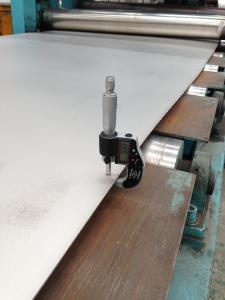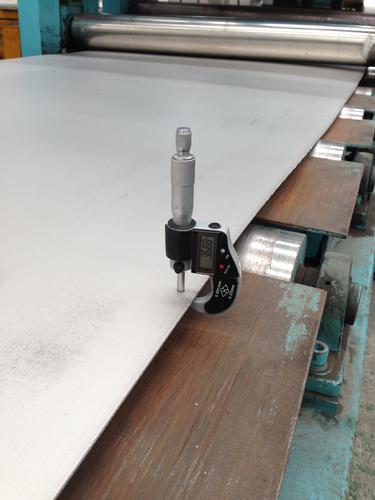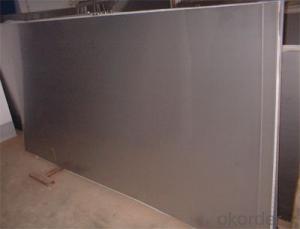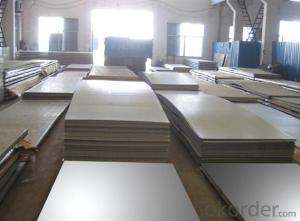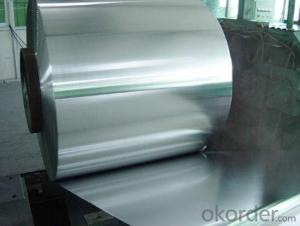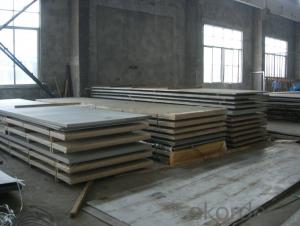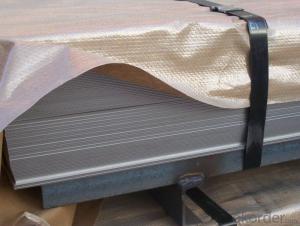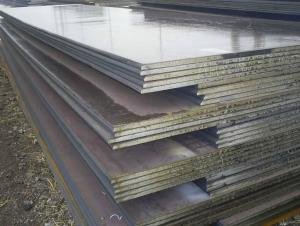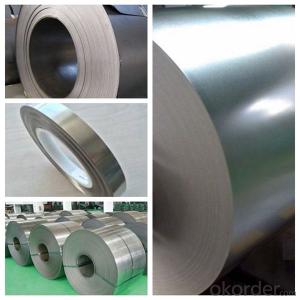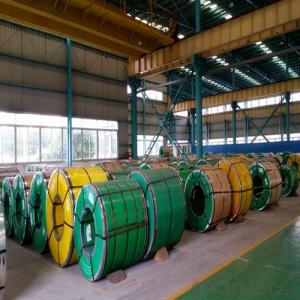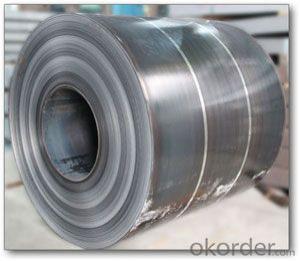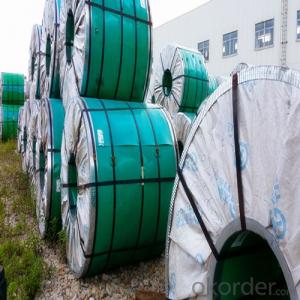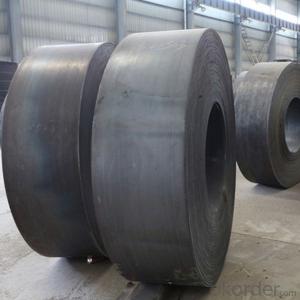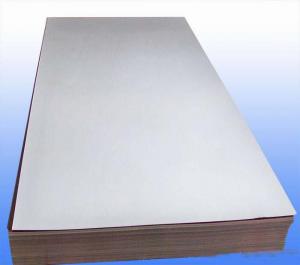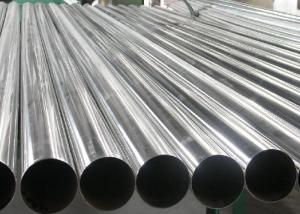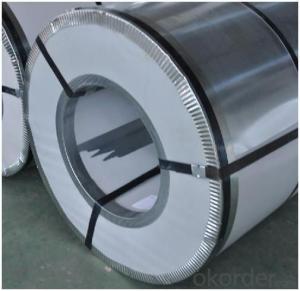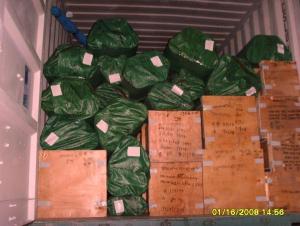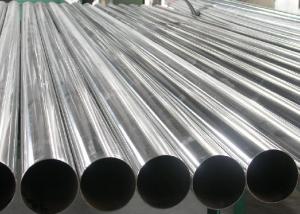Stainless Steel Coil Rolled Hot Rolled With Best Price
- Loading Port:
- Shanghai
- Payment Terms:
- TT or LC
- Min Order Qty:
- 4 m.t.
- Supply Capability:
- 5000 m.t./month
OKorder Service Pledge
OKorder Financial Service
You Might Also Like
1.Structure of Product Description
Cold rolled Stainless sheet is widely used in the construction field and decoration field, etc. There are many different grades, such as: 200 series, 300 series, 400 series, 900series, etc. gr are as follows: 201, 202, 301, 304, 316,430, etc.
The suace is including 2B, BA, Mirror Finish, Checkered, etc.
2. Main features of the product
a. Competitive price
b. Frist-Class Service.
3. Image.

4. Product detailed sizes:
1000mm*2000mm, 1219mm*2438mm,1220mm*2440mm, 1250mm*2500mm,1500mm*3000mm, etc.
5. FAQ:
What is the quality standard?
---Usually our standard is GB3880-2006 or else.
What is the width range?
---It is from 1mm to 2500mm, etc.
What is the length range?
---It is from 2000mm to 6000mm, etc.
What is the MOQ for your products yet?
---Normally itaround 3 tons/each size.
How many tons did you export in one year?
---Normally it 9000 tons totally.
Where is your client from?
---Normally it is?
---Normally they are stainless steel sheet, stainless steel coil, stainless steel checkered sheet, stainless steel mirror finished sheet, color coated stainless steel sheet, etc.
- Q: Can stainless steel sheets be used for decorative staircases?
- Indeed, decorative staircases can make use of stainless steel sheets. With its versatility, stainless steel emerges as a highly sought-after material in architectural and interior design domains, offering both aesthetic charm and long-lasting strength. When employed in decorative staircases, stainless steel sheets impart a polished and contemporary feel, elevating the overall allure of the staircase. Moreover, stainless steel's resistance to corrosion and staining renders it perfect for high-traffic zones such as staircases. Not only that, but it also boasts easy cleaning and maintenance, magnifying its appropriateness for ornamental intentions.
- Q: What are the benefits of using perforated stainless steel sheets in acoustics?
- Perforated stainless steel sheets in acoustics offer several benefits. Firstly, they can effectively control and manipulate sound waves by allowing sound to pass through the perforations while reducing the intensity of the sound energy. This helps in creating a more balanced and controlled acoustic environment. Secondly, these sheets can be used as sound absorbers, as the holes in the stainless steel sheet absorb and dissipate sound energy, reducing echoes and reverberations. Additionally, perforated stainless steel sheets are durable, corrosion-resistant, and aesthetically pleasing, making them a long-lasting and visually appealing solution for acoustic applications.
- Q: What are the color options for stainless steel sheets?
- Stainless steel sheets are typically available in a range of color choices, contingent upon the particular finish employed on the surface. The prevalent color selections for stainless steel sheets encompass silver, representing the inherent hue of stainless steel, in addition to black, gold, bronze, and copper. These hues are attained through techniques like powder coating, PVD coating, or chemical treatments, which establish a thin coating on the sheet's surface. The assortment of color choices grants enhanced design flexibility and the ability to select hues that harmonize with diverse aesthetics and applications.
- Q: What are the main chemical constituents of stainless steel plates?
- Stainless steel not only refers to a stainless steel, but more than one hundred kinds of industrial stainless steel, the development of each kind of stainless steel in its specific application areas have good performance. The key to success is to find out what the purpose is, and then determine the correct type of steel. There are usually only six kinds of steel related to the application of building construction. They all contain 17 to 22% chromium, and better steel also contains nickel. The addition of molybdenum can further improve atmospheric corrosion, especially for atmospheric corrosion resistant chlorides.
- Q: Are stainless steel sheets suitable for marine propellers?
- Yes, stainless steel sheets are suitable for marine propellers. Stainless steel is a popular material choice for marine propellers due to its excellent corrosion resistance properties, which is essential in a marine environment where the propeller is constantly exposed to saltwater. The high strength and durability of stainless steel sheets also make them capable of withstanding the harsh conditions of the marine environment, including impacts and vibrations. Additionally, stainless steel has a low magnetic permeability, which helps reduce the formation of biofouling on the propeller, improving its performance and efficiency. Overall, stainless steel sheets are a suitable and widely used material for marine propellers.
- Q: What is the thermal expansion rate of stainless steel sheets?
- The thermal expansion rate of stainless steel sheets varies depending on the specific grade of stainless steel and the temperature range in which it is exposed. Generally, stainless steel has a coefficient of thermal expansion (CTE) of around 10-17 x 10^-6 per degree Celsius (µm/m°C). This means that for every degree Celsius increase in temperature, the stainless steel sheet will expand by 10-17 micrometers per meter of length. It is important to note that the CTE can vary slightly for different grades of stainless steel, so it is recommended to consult the manufacturer's specifications or engineering handbooks for more precise information on the thermal expansion rate of a particular stainless steel sheet.
- Q: How do you determine the grade of a stainless steel sheet?
- To determine the grade of a stainless steel sheet, several factors need to be considered. Firstly, the composition of the stainless steel should be analyzed. Stainless steel is typically made up of a combination of metals such as iron, chromium, nickel, and other elements. The specific percentages of these metals will determine the grade of the stainless steel. For instance, a stainless steel sheet with higher chromium and nickel content will generally have a higher grade. Another important consideration is the mechanical properties of the stainless steel. These properties include the tensile strength, yield strength, and elongation of the material. Different grades of stainless steel will have varying mechanical properties, and these properties can be measured through standardized testing methods. Surface finish is also a factor in determining the grade of a stainless steel sheet. The finish can range from a rough, dull surface to a smooth, polished one. Different grades of stainless steel may have specific surface finishes, and this can be verified by visual inspection or by using specialized equipment. Additionally, the corrosion resistance of the stainless steel sheet plays a significant role in determining its grade. Stainless steel is known for its resistance to corrosion, and higher grades of stainless steel will typically offer better resistance to various corrosive environments. Corrosion testing methods, such as salt spray testing, can help assess the corrosion resistance of a stainless steel sheet. In summary, the grade of a stainless steel sheet can be determined by analyzing its composition, mechanical properties, surface finish, and corrosion resistance. By considering these factors, one can accurately identify the grade of a stainless steel sheet and determine its suitability for specific applications.
- Q: What are the common methods of cutting stainless steel sheets?
- There are several common methods of cutting stainless steel sheets, each with its own advantages and limitations. Here are a few commonly used methods: 1. Shearing: Shearing involves using a machine with two blades to slice through the stainless steel sheet. This method is suitable for thinner sheets and produces clean, straight cuts. However, it may leave a slight burr on the edge of the cut. 2. Plasma cutting: Plasma cutting is a versatile method that uses a high-temperature plasma arc to melt and blow away the metal. It is effective for cutting stainless steel sheets of various thicknesses and shapes. Plasma cutting provides fast, precise cuts and can handle both straight and curved lines. 3. Laser cutting: Laser cutting uses a focused laser beam to cut through stainless steel sheets. It is highly accurate and produces smooth, precise cuts with minimal distortion. Laser cutting is suitable for both thin and thick sheets, but it can be slower than other methods for thicker materials. 4. Waterjet cutting: Waterjet cutting involves using a high-pressure stream of water mixed with abrasive particles to cut through stainless steel. This method is precise and can handle various thicknesses and shapes. Waterjet cutting is known for its clean edges and the ability to cut without heat-affected zones. However, it may be slower than other methods and can be more expensive. 5. Sawing: Sawing is a traditional method that involves using a saw blade to cut through stainless steel sheets. It is suitable for thicker sheets and can handle both straight and curved cuts. Sawing produces relatively clean cuts but may result in more material waste compared to other methods. These are just a few of the common methods used to cut stainless steel sheets. The choice of method depends on factors such as the thickness of the sheet, desired cut quality, shape complexity, and budget. It is important to consider the specific requirements of the project and consult with professionals to determine the most suitable cutting method.
- Q: Can stainless steel sheets be used for food storage containers?
- Food storage containers can indeed be made from stainless steel sheets. Many people choose stainless steel for their food storage containers because it is durable, non-reactive, and resistant to corrosion. The stored food does not acquire any taste or odor, making it safe to store for extended periods. Moreover, stainless steel is easy to clean and maintain, ensuring optimal hygiene for food storage. Furthermore, stainless steel containers are often favored for their eco-friendly characteristics as they can be reused, thereby reducing the need for single-use plastic containers. In conclusion, stainless steel sheets are a dependable and appropriate option for food storage containers.
- Q: How do I determine the flatness of stainless steel sheets?
- To determine the flatness of stainless steel sheets, you can follow these steps: 1. Visual Inspection: Start by visually inspecting the sheet for any visible signs of warping, bending, or unevenness. Look for any noticeable waves, ripples, or twists in the surface. While this method may not be the most accurate, it can give you an initial idea of the sheet's overall flatness. 2. Measuring with a Straight Edge: Place a straight edge, such as a ruler or a long level, on the surface of the stainless steel sheet. Move the straight edge across different areas of the sheet, focusing on both the center and the edges. Observe if there are any gaps or spaces between the straight edge and the sheet. If the straight edge remains in full contact with the sheet throughout, it indicates a good level of flatness. 3. Using a Feeler Gauge: A feeler gauge is a precision measurement tool consisting of a set of thin metal blades of varying thicknesses. It can be used to measure the gap between the straight edge and the stainless steel sheet more accurately. Slide the feeler gauge into any gaps between the sheet and the straight edge, noting the blade thickness that fits snugly. This will help determine the extent of any unevenness or bowing present. 4. Laser Measurement: For more precise measurements, you can use a laser measuring device. Place the laser device on one end of the sheet and measure the distance from the laser to the surface at various points along the length of the sheet. Repeat this process on the opposite end of the sheet. Comparing these measurements will give you an indication of any differences in flatness. 5. Professional Testing: If the stainless steel sheets are intended for critical applications or if precise flatness is crucial, it may be wise to consult with a professional testing service. They can utilize advanced techniques such as optical profilometry or coordinate measuring machines to accurately measure the flatness of the sheet. It is important to note that due to the inherent characteristics of stainless steel, some slight deviations from perfect flatness may be acceptable within industry standards. The level of flatness required will depend on the specific application and the tolerance standards set by the manufacturer or customer.
Send your message to us
Stainless Steel Coil Rolled Hot Rolled With Best Price
- Loading Port:
- Shanghai
- Payment Terms:
- TT or LC
- Min Order Qty:
- 4 m.t.
- Supply Capability:
- 5000 m.t./month
OKorder Service Pledge
OKorder Financial Service
Similar products
Hot products
Hot Searches
Related keywords
